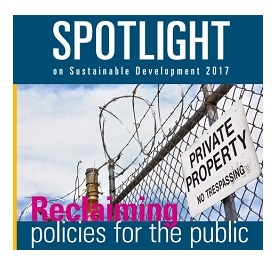“Spotlight on Sustainable Development 2017” : a comprehensive assessment of the 2030 Agenda and the SDGs


Source: [PDF] “Spotlight on Sustainable Development 2017” Report, 10 July, 2017 (160 p.)
The Spotlight Report on Sustainable Development 2017 : “Reclaiming policies for the public” - - published on the opening day of the High Level Panel on Sustainable Development in New York, USA - - provides a extensive assessment of the 2030 Agenda and the Sustainable Development Goals (SDGs).
_________________________________________________________________________________________________
The Spotlight Report's input has been provided by national and regional groups and coalitions all over the world and it is supported by a wide range of civil society organisations and trade unions.
The publication, which appears annually (see : Spotlight on Sustainable Development 2016: "The case for agroecology") is conceived as a global umbrella Report accompanying the reports presented by governments and international organisations on their implementation of the 2030 Agenda and the SDGs and its publications cover all the areas that the SDGs refer to, including agriculture and nutrition.
Take a look at: |
Implementing SDG 2
According to Stefano Prato of the Society for International Development, implementing SDG 2 addressing ending hunger, achieving food security and improved nutrition, promoting sustainable agriculture, is taking place in the context of a contrast between two worldviews on modernity and food and nutrition, which are supported by equally distant production, marketing and distribution systems.
Whereas smallholders currently account for up to 70 per cent of global food production, the need is emphasised to boost production and investments in agribusiness.
Biotechnologies are proposed to adapt intensive agriculture to the new climate conditions.
There is also a push for nutrition-sensitive agriculture and bio-fortification to make up for deficits from industrial products based on large-scale production of a handful of crops.
Concentration Processes versus diversity
The Action Group on Erosion, Technology and Concentration (ETC) - - which addresses socioeconomic and ecological issues surrounding new technologies that could affect the world’s poorest and most vulnerable people - - explains in the Spotlight Report, that concentration processes in the agricultural inputs sector is moving forward in huge strides.
Concentration processes in the pesticides and seed need paradigm shift towards diversity-based farming practices, argues Lim Lee Ching of the Third World Network. She calls for adopting approaches such as agroecology, that can also address the problem of climate change. Lim Lee Ching argues that concentration in power in food systems is leading to less diversity in the crops grown because of the tendency towards standardized, input-intensive crop varieties and away from traditional varieties and agricultural diversity.
Supported by DivSeek - - a major international gene-banking project - - the mega-agribusinesses could gain proprietary control of plant genes, sequences and traits, resulting in “the ultimate corporate capture of agricultural biodiversity that is meant to be held in trust”.
Simone Lovera of the Centre for Sustainable Development Studies (CSDS) at the University of Amsterdam stresses that biodiversity policy has been informed by neoliberal economic theories promoting the privatization and commodification of what biodiversity provides, and argues that reference under SDG 15 Life on Land to “ecosystems and their services” has supported a discourse on the values of these services and “encouraged governments to establish markets or other economic incentive schemes that provide payments for these ecosystem services”.
The FAO of the UN is mentioned in the Report in the following context :
*** The World Economic Forum vision includes a “public-private” UN, in which certain specialized agencies would operate under joint State and non State governance systems, such as the Food and Agriculture Organization (FAO) through a “Global Food, Agriculture and Nutrition Redesign Initiative”. This model also assumes that some issues would be taken off the agenda of the UN system to be addressed by plurilateral, often multi-stakeholder, coalitions of the willing and able.
***According to the Save Food Initiative of the Food and Agriculture Organization (FAO), every year around the globe, 1.3 billion tonnes of food are lost or wasted – that is one third of all food produced for human consumption. The countries of the global North waste almost as much food as the entire net food production of sub-Saharan Africa on annual basis and the amount of food lost and wasted every year is equal to more than half of the world’s annual cereal harvest.
Related content:
You might be interested in joining FREE E-learning Modules on Nutrition-sensitive Agriculture and Food Systems: © 2017 FAO/European Commission/ World Bank/ German Ministry of Food and Agriculture Nutrition, food security and livelihoods: basic concepts Improving nutrition through agriculture and food systems From nutrition situation analysis to nutrition-sensitive project design, monitoring and evaluation Agreeing on causes of malnutrition for joint action |

